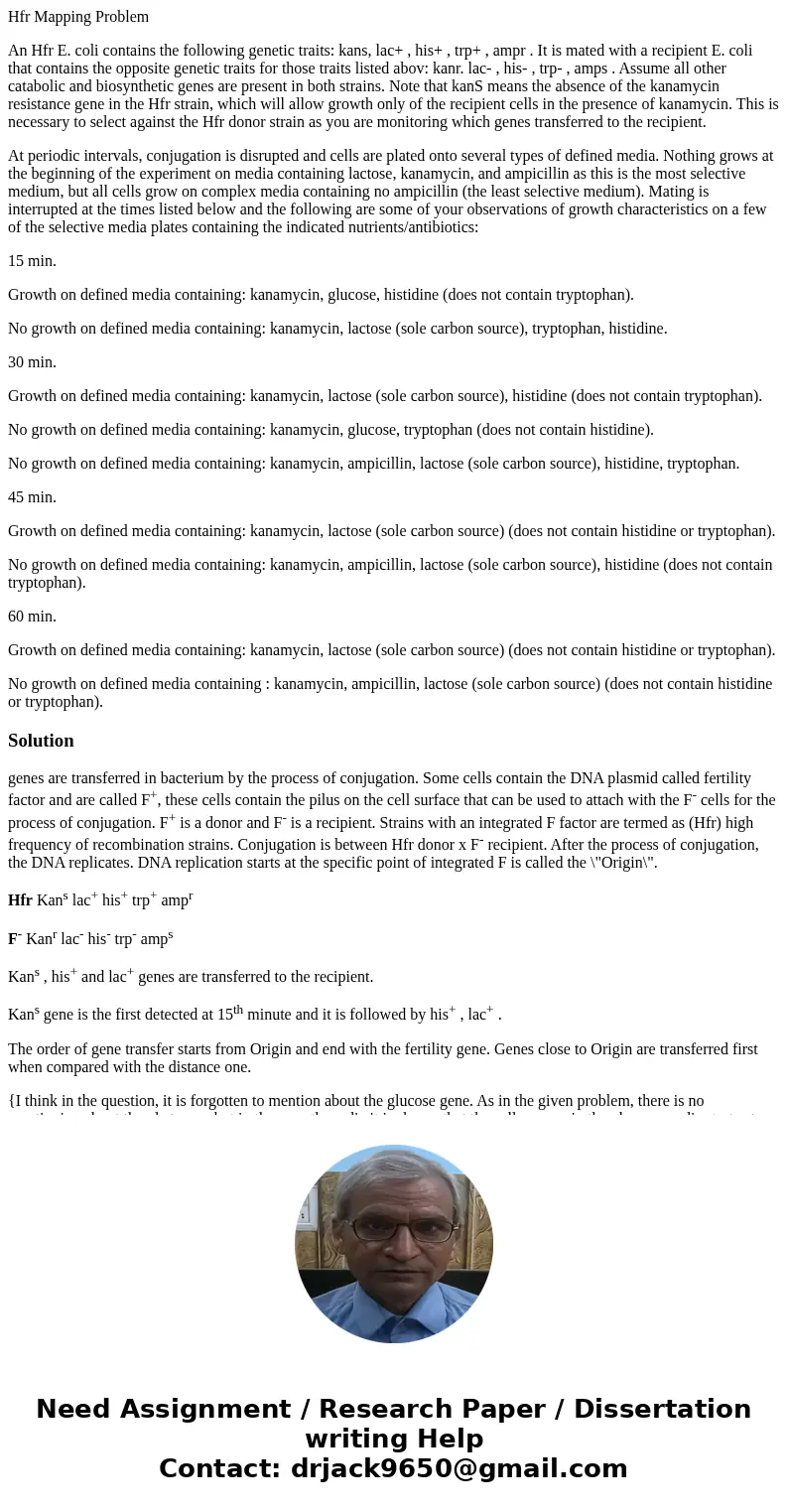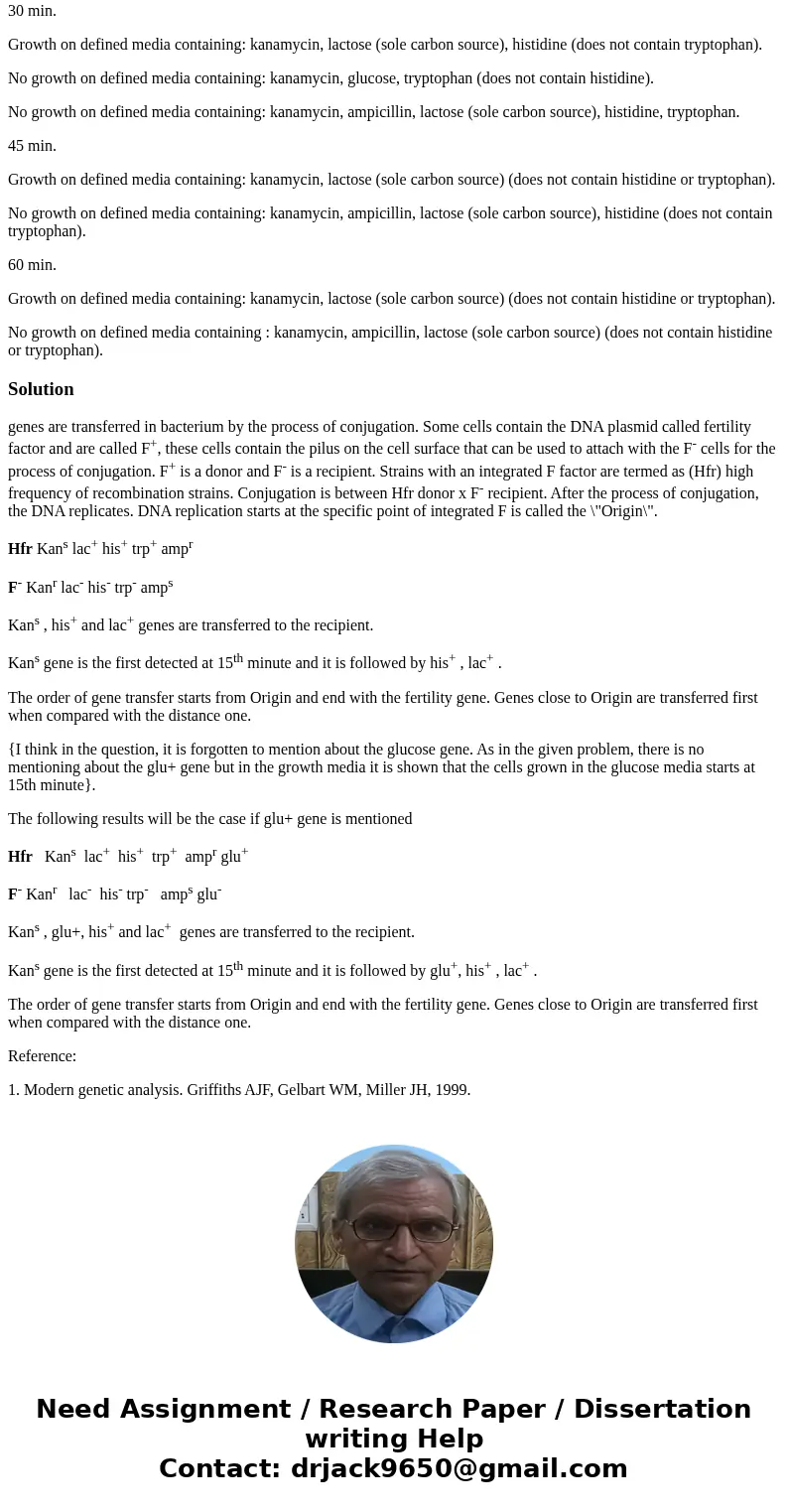Hfr Mapping Problem An Hfr E coli contains the following gen
Hfr Mapping Problem
An Hfr E. coli contains the following genetic traits: kans, lac+ , his+ , trp+ , ampr . It is mated with a recipient E. coli that contains the opposite genetic traits for those traits listed abov: kanr. lac- , his- , trp- , amps . Assume all other catabolic and biosynthetic genes are present in both strains. Note that kanS means the absence of the kanamycin resistance gene in the Hfr strain, which will allow growth only of the recipient cells in the presence of kanamycin. This is necessary to select against the Hfr donor strain as you are monitoring which genes transferred to the recipient.
At periodic intervals, conjugation is disrupted and cells are plated onto several types of defined media. Nothing grows at the beginning of the experiment on media containing lactose, kanamycin, and ampicillin as this is the most selective medium, but all cells grow on complex media containing no ampicillin (the least selective medium). Mating is interrupted at the times listed below and the following are some of your observations of growth characteristics on a few of the selective media plates containing the indicated nutrients/antibiotics:
15 min.
Growth on defined media containing: kanamycin, glucose, histidine (does not contain tryptophan).
No growth on defined media containing: kanamycin, lactose (sole carbon source), tryptophan, histidine.
30 min.
Growth on defined media containing: kanamycin, lactose (sole carbon source), histidine (does not contain tryptophan).
No growth on defined media containing: kanamycin, glucose, tryptophan (does not contain histidine).
No growth on defined media containing: kanamycin, ampicillin, lactose (sole carbon source), histidine, tryptophan.
45 min.
Growth on defined media containing: kanamycin, lactose (sole carbon source) (does not contain histidine or tryptophan).
No growth on defined media containing: kanamycin, ampicillin, lactose (sole carbon source), histidine (does not contain tryptophan).
60 min.
Growth on defined media containing: kanamycin, lactose (sole carbon source) (does not contain histidine or tryptophan).
No growth on defined media containing : kanamycin, ampicillin, lactose (sole carbon source) (does not contain histidine or tryptophan).
Solution
genes are transferred in bacterium by the process of conjugation. Some cells contain the DNA plasmid called fertility factor and are called F+, these cells contain the pilus on the cell surface that can be used to attach with the F- cells for the process of conjugation. F+ is a donor and F- is a recipient. Strains with an integrated F factor are termed as (Hfr) high frequency of recombination strains. Conjugation is between Hfr donor x F- recipient. After the process of conjugation, the DNA replicates. DNA replication starts at the specific point of integrated F is called the \"Origin\".
Hfr Kans lac+ his+ trp+ ampr
F- Kanr lac- his- trp- amps
Kans , his+ and lac+ genes are transferred to the recipient.
Kans gene is the first detected at 15th minute and it is followed by his+ , lac+ .
The order of gene transfer starts from Origin and end with the fertility gene. Genes close to Origin are transferred first when compared with the distance one.
{I think in the question, it is forgotten to mention about the glucose gene. As in the given problem, there is no mentioning about the glu+ gene but in the growth media it is shown that the cells grown in the glucose media starts at 15th minute}.
The following results will be the case if glu+ gene is mentioned
Hfr Kans lac+ his+ trp+ ampr glu+
F- Kanr lac- his- trp- amps glu-
Kans , glu+, his+ and lac+ genes are transferred to the recipient.
Kans gene is the first detected at 15th minute and it is followed by glu+, his+ , lac+ .
The order of gene transfer starts from Origin and end with the fertility gene. Genes close to Origin are transferred first when compared with the distance one.
Reference:
1. Modern genetic analysis. Griffiths AJF, Gelbart WM, Miller JH, 1999.


 Homework Sourse
Homework Sourse